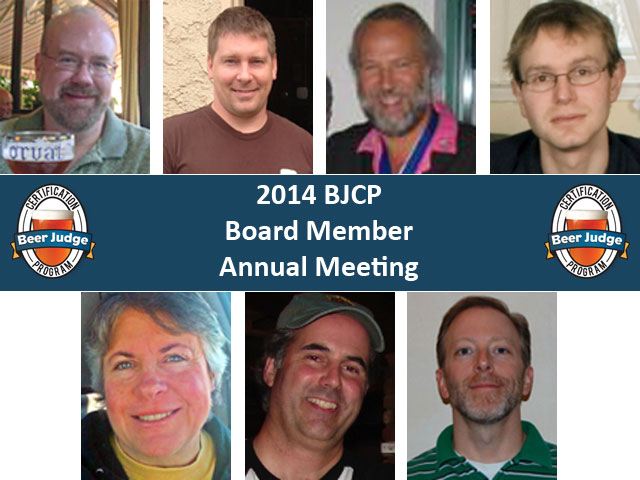|
The BJCP Board held its annual in-person board meeting at the 2014 National Homebrewers Conference in Grand Rapids, MI. The BJCP board conducts most matters over electronic communications, but the NHC provides an opportunity for board members to meet in person once a year.
Topics of discussion
The meeting began with an introduction for new Representatives on the structure and operation of the BJCP board, organization history, lessons learned from past experiences.
Board members next discussed the status of ongoing projects: style guideline revisions, grader training, vocabulary project, web migration.
Finally, the Board brainstormed opportunities for improvement and potential ideas and solutions.
Views expressed
Board members noted the following areas specifically for improvement in the next year:
- There is general support for ongoing operations with a desire for more involvement by individual board members and more delegation.
- Board members seek to keep pressing on the exam directorate to increase throughput to meet demand, while looking at reducing grader workload and decreasing grading turnaround time.
- Improve interactions within the board to provide clear direction, keep informed of status, and to accomplish more.
- Increase interaction between board and regional members to increase awareness of BJCP activities and to increase member input.
- Increase member participation in improvement processes, gather and track ideas in a more structured way, and then share the results of the efforts.
- Increase interaction between directors and board, conducting regular reviews and investigating need for additional resources and support.
- Clarify owners of specific documents and content areas, with a perioidic review and update schedule.
- Develop systems, processes, or documents to facilitate continual improvement of judging, scoresheet feedback, and practices.
- Increase educational content with emphasis on online training materials and videos, investigate mentoring program.
- Investigate rank expectations and impact on exam program.
- Increase opportunities for mead and cider exams, rework exam program for them to match beer.
- Increase transparency and interaction between the board and membership.
- Increase consistency of exam grading.
Action items and follow-ups
As a result of the views expressed, the board decided to take the following actions:
- Streamline the RTP process to reduce workload on lead graders, investigating checkbox RTP alternative.
- Investigate staffing and structure, including possible reorganization or expansion.
- Investigate tools for online collaboration, project status, and member suggestion tracking.
- Identify additional duties and responsibilities that can be delegated to board members or staff.
- Think about content management on the web site, and regular review and update of materials, identifying staffing and structure.
- Identify and prioritize opportunities for automation to reduce workloads.
- Start up an ethics committee to review judge standards and practices, update manuals, create code of conduct, and provide a venue for handling complaints regarding judging, competitions, exams.
- Encourage CEP directorate to develop grader training and advanced judge training materials, and to deliver to membership.
Member awareness
When asked what members should be aware of as a result of the meeting, President Gordon Strong provided the following notes:
- Whenever three or more board members are in the same place, we try to meet to discuss issues and identify future plans.
- Many of the topics discussed have far-reaching impact, and will take some time to investigate.
- The board is looking at direction, planning, and resource allocation more than interfering in day-to-day operations.
- Member input is highly valued; we look at ways to increase interaction within the context of an all-volunteer organization.
|

